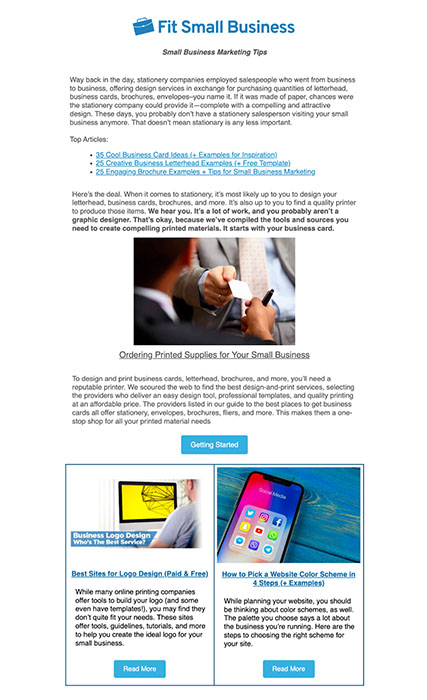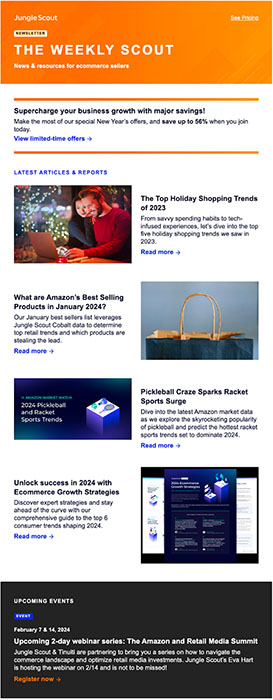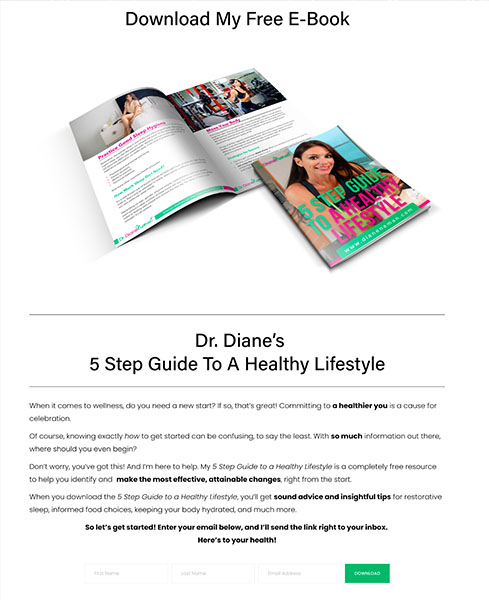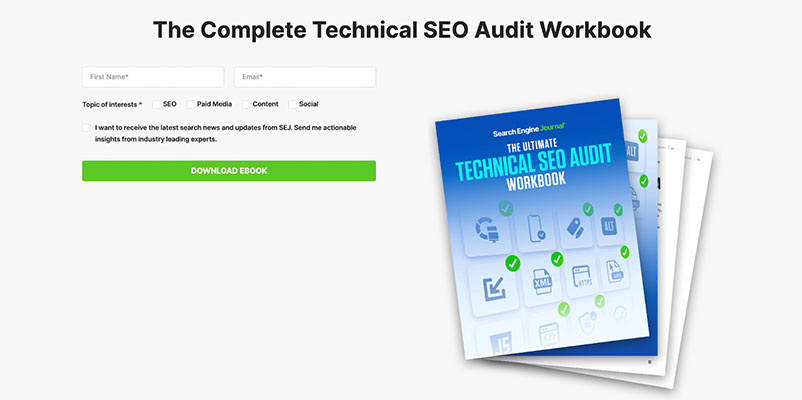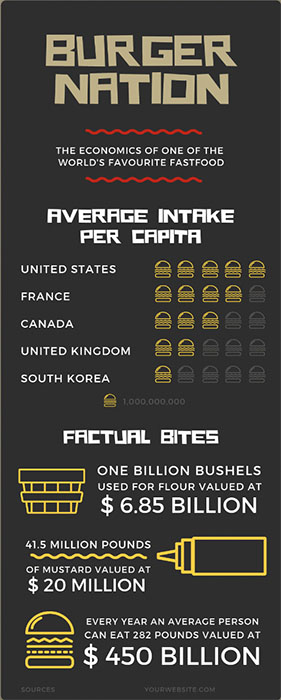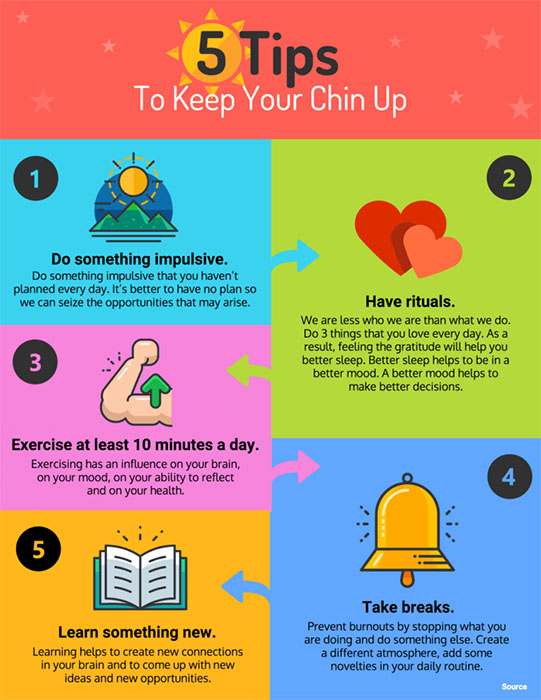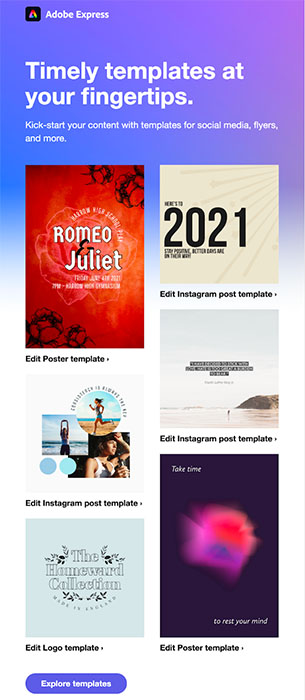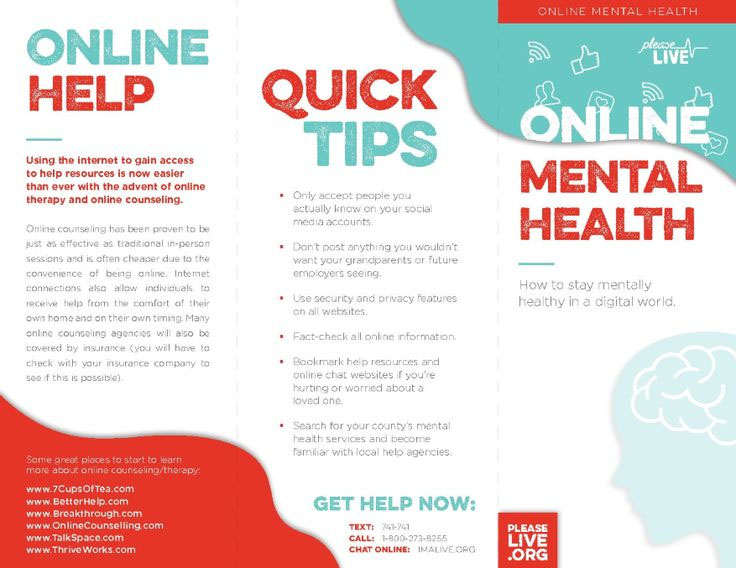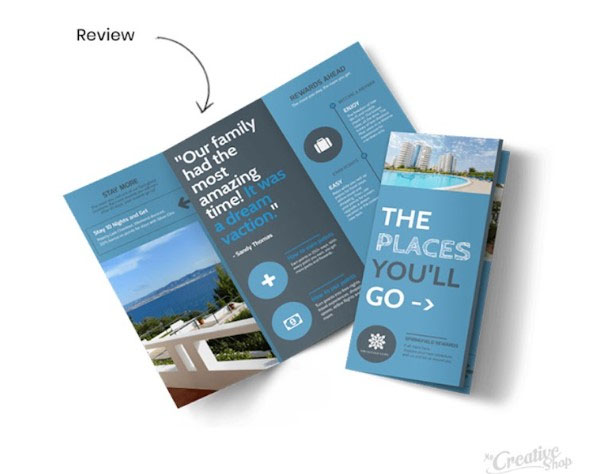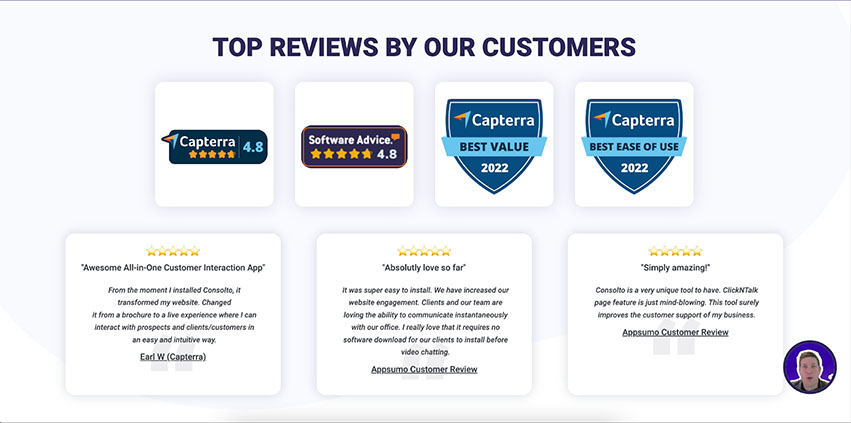Content marketing is a staple in marketing. In fact, it’s one of the most important marketing strategies you can employ for your small business—studies have found that it can even increase customers’ lifetime value by up to 70%.* Plus, it’s also one of the most versatile strategies around. In my experience as a marketer, I haven’t been a part of an effective campaign that doesn’t rely on content marketing in some way.
Take, for example, Spotify’s Wrapped series—it’s so simple, yet massively effective. Users anticipate its yearly arrival so they can see their listening behavior data and then eagerly share it on social media, essentially becoming Spotify brand ambassadors. The strategy works because it taps into the deeper human desire to understand one another. And it all comes down to optimizing one thing: content.
It’s been said by many before, and it’s worth repeating: content is king. But there’s more to this idea. Good content is king, not just any content. But what does good content actually mean? In today’s world, where millions of content are produced every day, thinking up effective content marketing ideas can be challenging. We can help you out. Keep reading to find 17 of the best content marketing tips and ideas for your small business.
*Source: Aspiration Marketing
1. Start a Small Business Blog
We’ve mentioned countless times in other articles how valuable blogging can be to building your business’ brand presence, and it’s still true. If you haven’t started a business blog yet, now is the time to do so. Blogging is the starting point to building a search engine optimized (SEO) content marketing plan. It can help you rank on your audience’s search engine results for searches related to your topic, and it can help build your business’ authority and credibility.

Blogs increase your search engine ranking and give users multiple entry points to your website, like this example from Ivory & Deene. (Source: Ivory & Deene)
And, it’s effective: According to HubSpot, blogging can increase website traffic by up to 55%. Start by mapping out content topics your audience will likely be searching for, their pain points, concerns, and frequently asked questions (FAQs). You can also do keyword research using tools like Semrush or Ahrefs. Many website builders have easy-to-use blogging tools that even complete beginners can use to publish blogs.
Having a blog opens up dozens more possibilities for marketing your business. It gives your audiences more points of entry into your website, allows for link building campaigns in the future and can even help you build an email contact list for newsletters.
Pro tip: Find out how to start a business blog the right way for your small business. Plus, see the best platforms to build your blog on in our guide to the best blogging platforms.
2. Repurpose Blogs Into Email Newsletters
One of the best things about content marketing is its versatility: One piece of content can be repurposed multiple times and into multiple formats.
This is also why one of the most useful content marketing topics and ideas for your small business is repurposing your blog content into email newsletters to extend its reach even further. Once you have enough contacts to build an email list, send a regular newsletter with some of your best blog content. Your newsletter can be themed around a certain topic (for instance, Fit Small Business has newsletters for each topic: Marketing, Sales, HR, etc.).
Newsletters are one of the most established ways of keeping your audience engaged with your brand. Some popular newsletter themes are news roundups, tips and advice, and industry analysis, and they can be sent weekly, monthly, or quarterly.
Pro tip: One more thing to add to your newsletters to encourage more sign-ups is exclusive deals like coupons or limited-time offers. Find out more about how to leverage emails in our guide to email marketing.
3. Support Content Marketing With Case Studies
As a small business owner, when you’re looking for advice on the best way to do something, you probably don’t try to do things the way large companies like Microsoft do them. Instead, you turn to other small business owners. Your potential customers, however, are the same way—they like to see perspectives they can relate to. That’s where case studies come in.
A case study takes a single customer or client and examines their needs, demonstrating how your product or service has impacted their desired outcome. For example, if you are an accountant, you might publish a case study outlining the services and resources your firm utilized to help a local landscaping company reduce overhead costs through better accounting practices.
Consider this SportClips case study from Brand J, a marketing firm, outlining how it helped its client grow leads and locations:
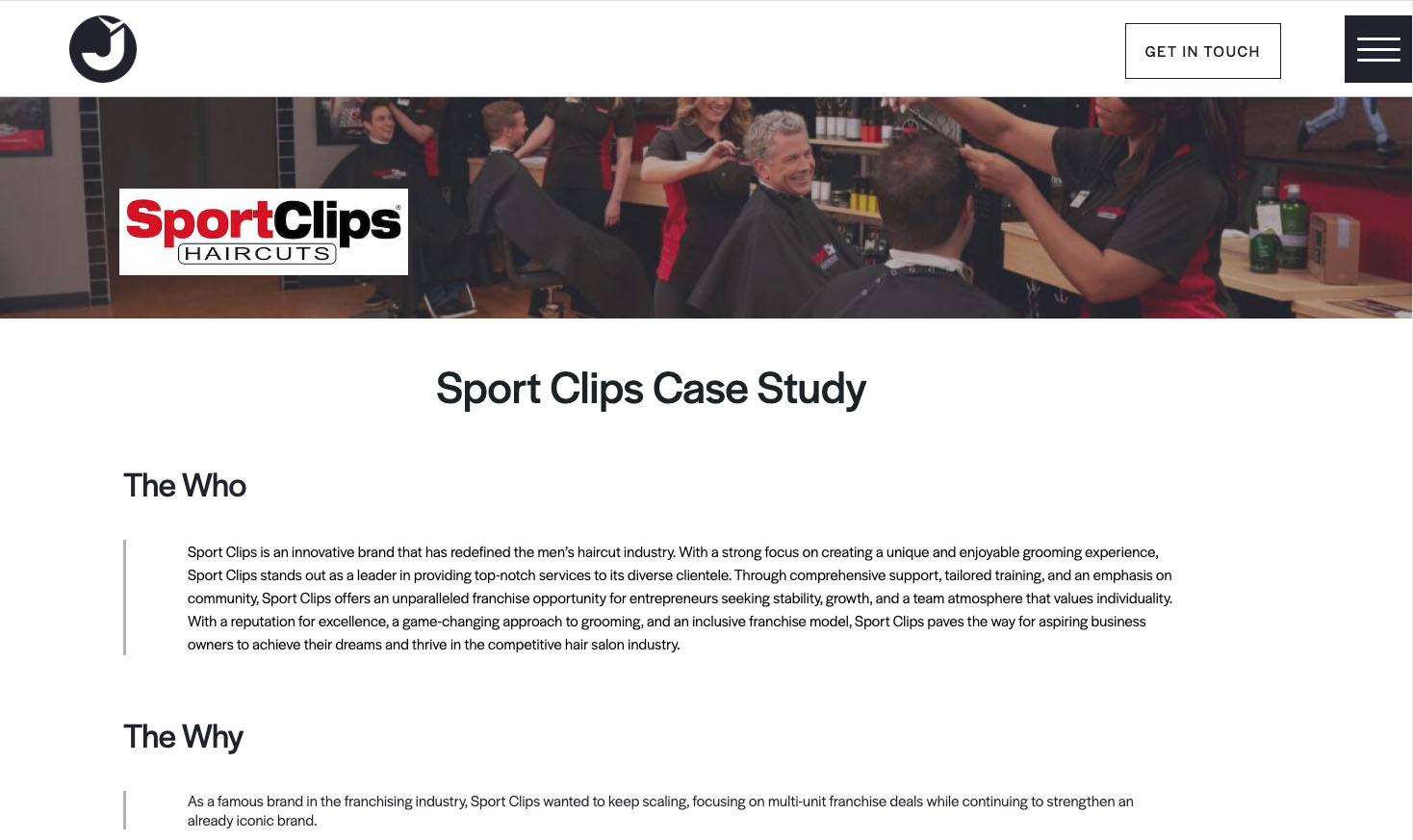
Brand J’s case study of SportClips is simple, straightforward, and brief. (Source: Brand J)
This case study is brief—running just under 450 words. Yet, if you read this write-up, you can see the services Brand J provided to SportClips, the strategy behind each service, and most importantly, the results. Notably, the firm provided a video case study as well, which highlights additional details. If video is in your budget, see the section about creating engaging video content below.
4. Invite Guests to Write for Your Blog
Creating lots of content regularly for your blog can be challenging and time-consuming. But the good news is there are hundreds of bloggers in any given field, many of whom are willing to collaborate with other small businesses and websites via guest posts, like in the example below.

Guest bloggers can help create more content for your blog at low costs. (Source: Hand Luggage Only)
Bloggers will usually let others know if they’re open to writing for other blogs, and they usually charge relatively low costs (typically between $50 and $100 per post). However, some are also happy to write content in exchange for backlinks to their website. These types of partnerships are mutually beneficial: they help create more content for your blog and help boost search engine optimization (SEO) across both sites.
Either way, it’s one of the most useful content marketing tips. Having a guest write for your blog can also bring in new audiences to your site—just be sure your guest blogger is also in the same niche or industry as yours.
5. Publish an E-book
If you’ve already built enough content on your blog, one way to build your authority even further is by publishing a free e-book that users can download. E-books accomplish two things: they establish your authority in your field, and they give your audience a piece of your brand they can download and keep wherever they are. And they aren’t too complicated to make: platforms like Canva have ready-to-edit templates you can use for free.
Your e-book can be about anything about your industry that warrants in-depth discussions or instructions. For instance, if you run a landscaping service, you might publish an e-book with tips on maintaining a landscape at home. Or, for example, if you own a sustainable grocery store, your audiences might be interested in an e-book with steps on living a more sustainable lifestyle.
Whatever topic you choose, be sure to provide valuable content that your audience would genuinely be interested in and would willingly download from your site in exchange for their information. When done well, your e-book can generate high-quality leads you can convert into customers.
Pro tip: After creating your e-book, make sure your audience sees it by promoting it on your website through landing pages like pop-ups and sign-up forms. Learn more about building effective landing pages.
6. Educate Customers Through Video
Have you ever been stuck with a particular problem—say fixing a leaky faucet—then found yourself searching on YouTube for a solution? If you have, you’re not alone. YouTube has since grown into the default browsing platform for all things instructional video content, from fixing leaky faucets to designing a website. This is because video can often be a much more effective teaching tool than written content.
Pet retail brand Chewy has some of the best educational video content. (Source: YouTube)
So while blogging is one way to build your topic authority, video can be just as impactful. Take a look at the example above from pet retailer brand Chewy. Their YouTube channel is filled with helpful information on all things pet-related, which are all useful to their target audience of pet owners. It’s also far more interesting than promotional content and therefore more likely to keep audiences engaged.
Pro tip: Your educational videos don’t have to live solely on YouTube—you can also repurpose them as shorter-form videos for social media like Instagram Reels or TikToks.
7. Feature Your Customers in a Video Testimonial
Customers like hearing from fellow customers—it’s been proven time and again to be effective in marketing. Not only because it fosters your credibility, but it also helps you build an active online community. And while writing them via case studies is effective, one way to maximize their impact even further is by using video, like in the example below from packaging brand Noissue:
Video testimonial series like these from customers increase your credibility and help build an online community. (Source: YouTube)
With ads on practically every screen, it’s personal stories like these that audiences connect with the most. Coupled with video’s inherent ability to capture and engage viewers, it overall makes for a potent content marketing strategy.
8. Show Behind-the-scenes Content on Social Media
Not all video content needs to be produced to a high shine. On the contrary, today’s audiences are more geared toward less commercial, more authentic-feeling videos with real, relatable people—just look at TikTok’s meteoric rise as any indication. So, if you don’t have the budget to produce professional quality videos, create social media videos instead.
@stirofbeauty SMALL BUSINESS BEHIND THE SCENE PART 1 ( BUSY DAY ) 📸. #stirofbeauty #stirofbeautyasmr #businessvlog #behindthescenes ♬ d a n d e l i o n s – 𖥦 ⪧ 𝐬𝐮𝐦𝐦𝐞𝐫 🌹
Behind-the-scenes video content like this is popular on social media and makes your brand feel more authentic to audiences. (Source: TikTok)
In particular, one of the best content marketing strategies for social media is to produce videos highlighting your team or products. And they don’t even need to be super-professional quality. Content like day-in-the-life and behind-the-scenes videos are not only popular from Instagram to TikTok, but they also show off your brand personality and values.
The key to making these videos work is authenticity. Audiences can easily tell video content that’s forced or promotional, which can ultimately backfire.
9. Host a Social Media Q&A
Virtually all organic content by brands on social media classifies as content marketing. Social media is built on content, and content is what attracts audiences and builds a loyal online community. But social media is also unique in that it’s the only platform where you can interact with your online community in real time, via live broadcast features like Instagram or TikTok Live.
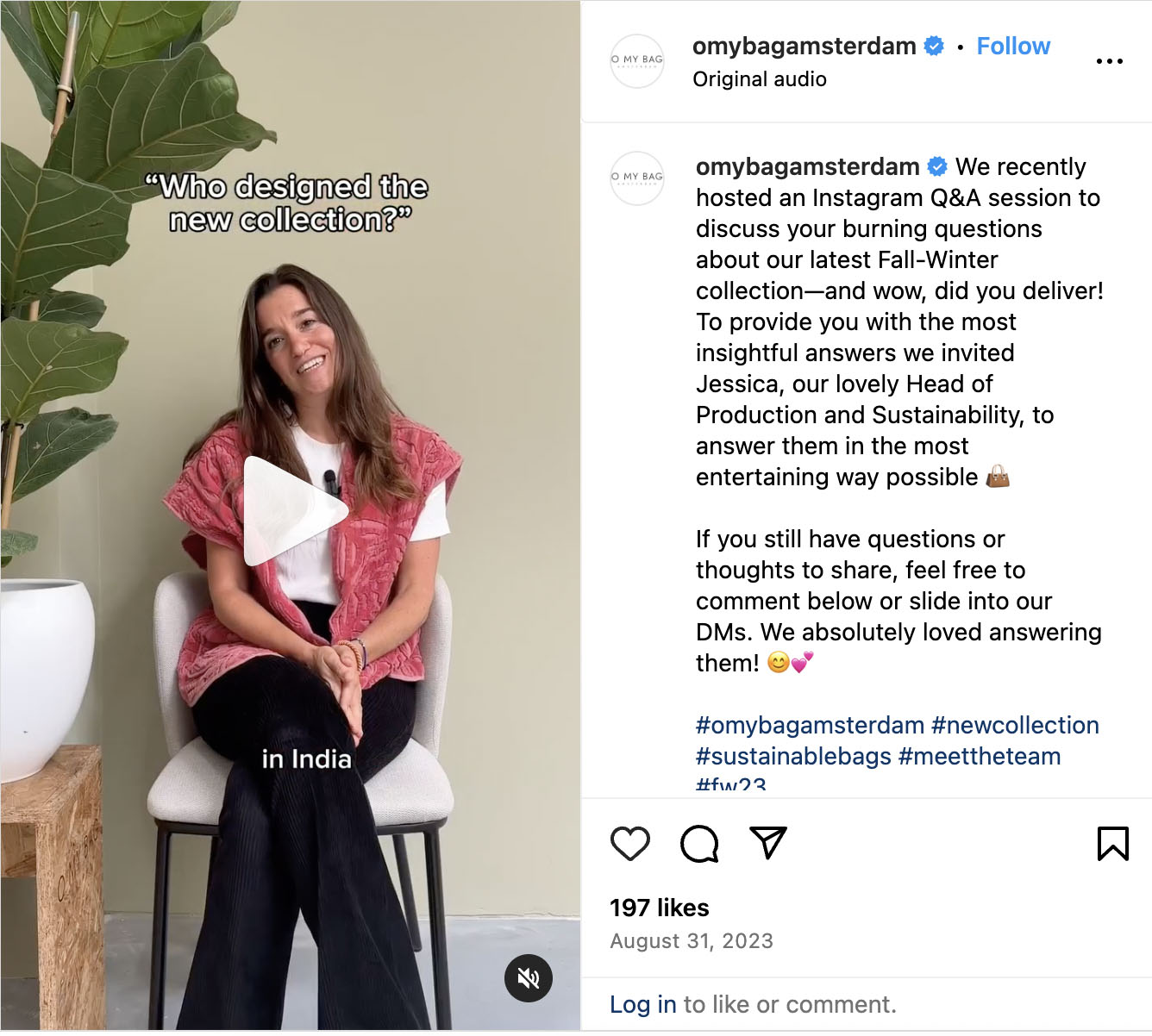
Live Q&A sessions are one of the best content marketing ideas for social media. They offer a personal way of connecting with your audience. (Source: Instagram)
Tools like these mean live broadcasts aren’t limited to television studios or big brands anymore. One of the best ways to leverage these live tools is by hosting live Q&A sessions with your followers and addressing some of your most asked questions. Live Q&A sessions offer a more personal and direct way of communicating with your audiences while at the same time giving them valuable information.
10. Post Infographics on Social Media
You already know that social media is invaluable to marketing your small business today. But social media is also only effective with regular posting, and thinking up new content ideas can be challenging. The good news is that if you already have a blog, you don’t always need to think up new social media content—you can repurpose what’s already there.
Infographics are one of the most popular content on social media today, and it’s not hard to see why. They condense complex information into easily digestible, bite-sized, share-worthy pieces, like the examples below. And therefore, they’re a great option for sharing any type of content, from statistics and research findings to tip lists and how-tos.
11. Send Drip Email Campaigns
Newsletters aren’t the only content you can send in your email campaigns. In fact, one of the most effective content marketing ideas for email is drip email marketing. These are email campaigns sent one at a time to customers to lead them through the entire sales funnel. It usually starts with a welcome email for new subscribers, followed by an educational email about your product or service, and then finally a conversion email to promote a sale.
Drip email campaigns work because they’re a more focused and personal way of communicating with your audience—especially compared to social media where you’re competing with hundreds of other brands for attention. A more focused audience means a higher chance they’ll read your content and follow your calls to action.
12. Send Informational Pamphlets in Direct Mail
Think direct mail marketing is a thing of the past? Research shows that it might actually be the opposite: the digital overload audiences are feeling may be amplifying the effectiveness of direct mail instead. And, when it comes to content marketing via direct mail, some of the most established are informational pamphlets.
Pamphlets are a staple in direct mail, and they allow more information than flyers or postcards. This means you can go beyond the usual product descriptions or announcements and share valuable information like useful tips, guides, or infographics.
13. Create Webinars to Generate Leads
You might have heard that nothing compares to live events when it comes to marketing. And there’s some truth to it: live events create memorable customer experiences, increase your brand awareness, and generate leads. Fortunately, not all live marketing events need to be done in person. One of the most effective (yet under-the-radar) ways to promote your business is through webinars, like in the example below.
Webinars are one of the best content marketing strategies for online live events, especially for generating leads. (Source: Vitality UK)
Webinars are also one of the best ideas for content marketing because they’re informative: people attend webinars to learn something new. So if you have relevant insights to share about your industry or have experts you can invite, hosting webinars can generate real, high-quality leads you can convert into long-term customers.
14. Host a Podcast
If you’ve ever listened to a podcast, you know how engaging and captivating they can be. They can also be one of the best content marketing ideas for your business. Podcasts can get the word out about your brand, build an engaged and captive audience who come back for each episode, and generate word-of-mouth—much like television shows, but at a fraction of the cost.

A great example of podcast content marketing is Headspace’s “Radio Headspace”’ podcast. (Source: Spotify)
If you have good content ideas (hint: take some from your blog) and guests you can invite (such as experts in your field), all you need is a good microphone and a studio room and you can easily start recording your first podcast episode. Streaming platforms like Spotify and Pandora also allow you to host podcasts free of charge.
15. Use Testimonials in Print Marketing Materials
You might think that content marketing is limited exclusively to digital marketing, but it has value offline too. One of the best examples is using your positive online reviews as testimonials to include in printed marketing materials like brochures, flyers, or even billboards, as in the example below.
Printed materials like these promote your brand to your local community. And, one way to make them even more impactful is by adding customer testimonials, which lend a sense of credibility to your business. And the best part is they’re easy to collect. If you have reviews on your Google Business Profile or Yelp page, you can collect the best ones to add to your print materials. Of course, always get consent first.
16. Feature Positive Reviews on Your Website
Positive reviews can be a powerful marketing tool—especially in an age when customers trust fellow customers more than brands. And it’s a trend that isn’t slowing down anytime soon. So how can you leverage this growing trend as a small business? A good way is by highlighting positive reviews about your business front and center when building your business website, like in the examples below.
Reviews count as content marketing. What makes them so powerful is that they’re authentic and therefore more relatable to audiences. This is also why they make for some of the best content marketing ideas. When users see positive reviews about your business on your website, it instantly builds a sense of trust and credibility. Many website builders have plugins that let you display reviews on your home page, or you can build them manually.
Highlighting customer reviews is a form of user-generated content (UGC) marketing because it leverages content created by users to promote your brand. It’s also one of today’s most cost-effective marketing strategies. Find more about how to use UGC marketing.
17. Use AI to Streamline Content Creation
Content marketing offers plenty of rewards. But it also takes lots of effort and content creation, which can be difficult for any small business owner—especially when you’re juggling dozens of other responsibilities every day. But you might have also heard of a little thing called artificial intelligence (AI) over the past year.
Ever since generative AI arrived on the scene courtesy of ChatGPT in November 2022, it’s exploded across the marketing landscape. From helping generate first drafts for blogs and email content to helping plan out your keyword strategy quickly, incorporating AI tools into your process might just be one of the best content marketing tips you can use to streamline your content marketing process.
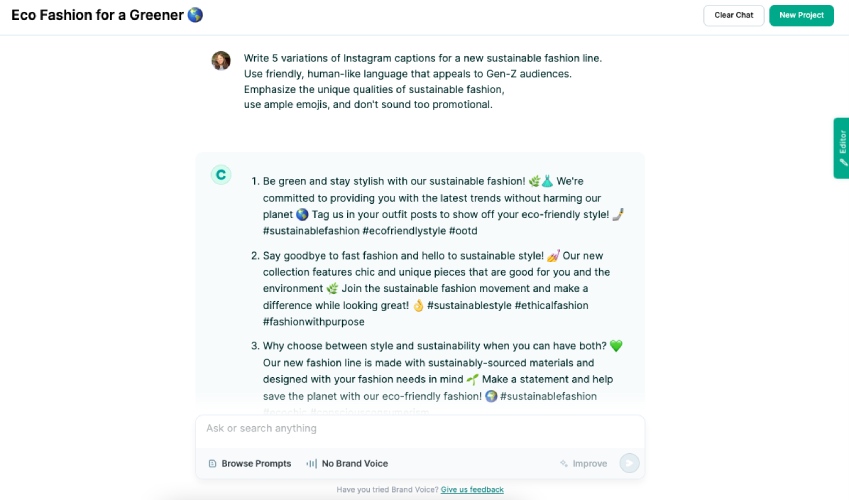
AI tools can help generate marketing copies, like in this example from Copy.ai. (Source: Copy.ai)
Some of the best AI content creation tools we’ve seen so far are ChatGPT, Copy.ai, Semrush, and even Canva’s image generation tools. Find out more about how to leverage AI for your small business in responsible ways in our guide to AI in content marketing.
While AI-generated content is usually technically accurate, it still lacks the nuance and emotion of human-written content. To make sure your AI content doesn’t sound too robotic, always edit it before publishing it live. Rewrite generic sentences, adjust its tone, and add an overall human touch, so it connects with audiences better. AI is at its best when combined with human expertise.
Frequently Asked Questions (FAQs)
Content marketing is one of the most important strategies to market your small business for many reasons: it boosts your SEO, builds your brand’s authority, keeps customers engaged, and even helps convert leads to sales. This means it’s effective for every stage of the marketing funnel. Plus, it’s also low-cost, making it suitable for small businesses. And unlike paid ads, content marketing is more authentic and therefore more credible to audiences.
A good content marketing idea should, above all, provide real value to your audience. Whether it’s an instructional blog, a tutorial video, or a social media infographic, the content you share should foremost be valuable and helpful to your audience. Valuable content organically makes your brand more credible, eventually building long-term trust. Good content marketing ideas are also authentic and customized to your audience’s wants and needs.
Some content marketing strategies can be done independently, such as establishing a blog or creating social media content. However, other strategies are more comprehensive and will need more expertise (for example, producing video series or sending email campaigns). For these strategies, hiring a content marketing manager or partnering with a content marketing service will bring better results.
Bottom Line
As the content marketing ideas above show, content marketing is varied and versatile. But these ideas all share one thing in common: they offer audiences real value that organically builds trust, which eventually can turn into brand loyalty. Use the content marketing tips above as a starting point to build your business’ content strategy, and partner with one of the best content marketing services to get expert help.
